
Unexplained infertility is a diagnosis given to couples who have been trying to conceive for at least a year but have no identifiable cause of infertility. Infertility diagnosis typically involves a series of tests and evaluations to determine the underlying cause of the problem. In cases of unexplained infertility, all tests come back normal, leaving doctors unable to pinpoint a specific cause. This can be frustrating for couples who are hoping for spontaneous conception or spontaneous pregnancy, as they may not understand why they are having difficulty getting pregnant. In some cases, couples may choose to pursue ivf treatment in order to increase their chances of achieving spontaneous pregnancies.
Despite the lack of a clear cause, unexplained infertility affects up to 30% of couples struggling with infertility. Some experts suggest that unexplained infertility may be caused by subtle abnormalities in egg or sperm quality, or issues with embryo implantation. Further research is needed to better understand the causes and treatment options for unexplained infertility, as it can affect the chances of spontaneous pregnancies or spontaneous conception. In some cases, couples may need to consider an ivf cycle to increase their chances of having a baby.
If you are one of the many couples struggling with unexplained infertility, it can be frustrating and disheartening. However, there are still steps you can take to increase your chances of spontaneous conception and spontaneous pregnancy. If these methods don’t work, you may consider undergoing ivf treatment to increase your chances of spontaneous pregnancies.
Firstly, consider making lifestyle changes that can improve your overall health and fertility, especially for infertile couples seeking infertility treatment. This includes maintaining a healthy weight through regular exercise and proper nutrition, reducing stress levels through activities like yoga or meditation, quitting smoking if applicable and avoiding alcohol consumption. It is also recommended to seek advice from a gynecologist to increase the chances of successful pregnancies.
Secondly, infertile couples may consider seeking out alternative infertility treatments such as acupuncture or herbal supplements which have been shown to improve fertility in some cases. It’s important to note that these therapies should always be used under the guidance of a qualified practitioner and can be used in conjunction with IVF treatment for patients who require it.
Thirdly, patients should work closely with their doctor or fertility specialist, including providers in Ferrara, on developing an individualized treatment plan tailored specifically for them and their partner’s needs. This may include medications such as Clomid or Letrozole which stimulate ovulation in women and increase sperm count in men respectively, based on the latest study findings.
Finally, don’t give up hope, patients! While it may take longer than expected or require more intervention than initially anticipated, many couples struggling with unexplained infertility do eventually go on to conceive naturally or with assisted reproductive technology like IVF. According to a study conducted by providers in Ferrara, there is still a chance for success.

Understanding Unexplained Infertility Statistics and Chances of Pregnancy
Unexplained infertility is a frustrating diagnosis for many couples trying to conceive. It occurs when no clear cause of infertility can be found after thorough testing and evaluation. According to a recent study, unexplained infertility affects around 10-30% of patients seeking fertility treatment. IVF treatment is often recommended by providers as a potential solution for couples struggling with unexplained infertility.
Spontaneous Pregnancy Rates
Couples with unexplained infertility, according to a study, have a spontaneous pregnancy rate of 1-4% per month, which is lower than the general population’s average. The likelihood of conception decreases as the woman’s age increases, especially after 35 years old. This means that the older a woman gets, the harder it becomes for her to conceive naturally. Patients can take this into consideration when seeking medical advice.
Sperm Count and Motility
Sperm count and motility can affect the chances of spontaneous conception and live birth rates. Patients with concerns about their fertility may undergo fertility testing to determine their sperm count and motility. A low sperm count or poor sperm motility can decrease the chances of natural conception. In such cases, fertility treatment such as assisted reproductive technologies such as IVF may be recommended.
Assisted Reproductive Technologies (ART)
IVF is one of several ART options available for patients with unexplained infertility. It involves fertilizing an egg outside the body in a laboratory setting before transferring it into the uterus. IVF has been shown to increase the chance of pregnancy for patients with unexplained infertility.
Success Rates
The success rates of fertility treatment such as IVF vary depending on factors such as age, embryo quality, and number of embryos transferred. For patients undergoing fertility testing, women under 35 years old using their own eggs have success rates typically between 40-60%. However, success rates decrease as women get older or use donor eggs.

Exploring Treatment Options for Unexplained Infertility
Infertility can be a challenging and emotional journey, but there are various fertility treatments available to help couples increase their chances of getting pregnant. Fertility specialists may recommend different treatment options based on the patient’s medical history and test results.
IVF – A Common Fertility Treatment for Unexplained Infertility
Assisted reproductive technology (ART) such as in vitro fertilization (IVF) is a common fertility treatment for unexplained infertility. During IVF, eggs are retrieved from the ovaries and fertilized with sperm in a laboratory setting. The resulting embryos are then transferred into the uterus. This procedure has been shown to be highly effective in helping couples achieve pregnancy.
Advanced Therapies like ICSI and PGT Used in Conjunction with IVF
Advanced therapies like intracytoplasmic sperm injection (ICSI) and preimplantation genetic testing (PGT) can also be used in conjunction with IVF. ICSI involves injecting a single sperm directly into an egg, which is then implanted into the uterus. PGT is used to screen embryos for chromosomal abnormalities before they are implanted into the uterus.
Fertility Drugs and Medications May Be Prescribed to Stimulate Ovulation
Fertility drugs and medications, et al, may be prescribed to stimulate ovulation and increase the number of eggs produced. These medications work by regulating hormone levels in the body, which can help improve fertility rates. Clomiphene citrate is one such medication that is commonly used to treat unexplained infertility.
Personalized Treatment Plan Can Improve Success Rates of Fertility Treatments
Studies have shown that a personalized treatment plan tailored to each patient’s specific needs can improve the success rates of fertility treatments. This approach takes into account factors such as age, medical history, and test results when determining the best course of action.

Improving Chances of Pregnancy: Effective Strategies and Tips
Lifestyle Changes Can Significantly Improve the Chances of Pregnancy Success
If you’re trying to conceive, lifestyle changes can go a long way in improving your chances of pregnancy success. Studies have shown that certain lifestyle changes can boost egg production and fertilization. For example, maintaining a healthy weight, eating a balanced diet, and avoiding smoking and alcohol can all positively impact fertility.
Managing stress is crucial for fertility. High levels of stress can interfere with ovulation and reduce sperm count in men. Therefore, it’s important to find ways to manage stress, such as practicing yoga or meditation.
A Combination of Lifestyle Factors and Medical Interventions Can Increase Success Rates
While lifestyle changes are essential for improving fertility, sometimes medical interventions may be necessary. A combination of lifestyle factors and medical interventions can increase success rates. For instance, assisted reproductive technologies (ART) like in vitro fertilization (IVF) or intrauterine insemination (IUI) can help couples with unexplained infertility achieve pregnancy.
Good News: Success Rates for Live Birth with Unexplained Infertility Are Still High
Couples who are struggling with unexplained infertility may feel discouraged about their chances of having a baby. However, good news is that the success rates for live birth with unexplained infertility are still high. In fact, studies have shown that couples who undergo ART have an overall success rate of 40% per cycle.
Making Healthy Choices and Managing Stress Can Positively Impact the Fertility Process
Making healthy choices is key. This includes maintaining a healthy weight through regular exercise and eating a balanced diet rich in fruits and vegetables. Avoiding smoking and alcohol is crucial for both partners.
Managing stress is also important for the fertility process because high levels of stress can interfere with ovulation in women and reduce sperm count in men. Finding ways to manage stress such as practicing relaxation techniques or seeking counseling can help improve your chances of conceiving.

Working with a Fertility Specialist to Identify and Address Lifestyle Factors Can Increase the Chances of Having a Baby
If you’re struggling to conceive, working with a fertility specialist can help identify and address lifestyle factors that may be impacting your chances of having a baby. A fertility specialist may recommend lifestyle changes such as weight loss or stress management techniques, as well as medical interventions like ART.
When to Seek Medical Help for Unexplained Infertility
If you have been trying to conceive for a year or more without success, it is time to seek medical help. Infertility affects millions of couples worldwide, and unexplained infertility is a diagnosis of exclusion, which means that all possible causes of infertility have been ruled out. Seeking medical help early can increase your chances of successful conception and a healthy pregnancy.
Your healthcare provider may recommend a series of tests to determine the cause of your infertility. These tests may include semen analysis, ovulation testing, hysterosalpingography (HSG), and laparoscopy. Semen analysis is used to evaluate the quality and quantity of sperm in the semen. Ovulation testing involves measuring hormone levels in your blood to determine if you are ovulating regularly. HSG is an X-ray procedure used to check whether your fallopian tubes are open or blocked. Laparoscopy is a surgical procedure used to examine your reproductive organs for any abnormalities.
Treatment options for unexplained infertility may include fertility drugs, intrauterine insemination (IUI), or in vitro fertilization (IVF). Fertility drugs such as clomiphene citrate and gonadotropins stimulate ovulation in women by regulating hormone levels. IUI involves placing sperm directly into the uterus during ovulation using a catheter. IVF involves fertilizing eggs with sperm outside the body and then transferring the resulting embryos into the uterus.
It is essential to remember that seeking medical help does not mean you will need invasive treatments immediately; lifestyle changes such as quitting smoking, reducing alcohol intake, maintaining a healthy weight, and reducing stress can also improve fertility outcomes.

Management and Treatment: Female Age and Unexplained Infertility
Female age is an important factor to consider in the management and treatment of unexplained infertility. While there is no single cause for unexplained infertility, female age can significantly impact a woman’s ability to conceive. As women age, their ovarian reserve decreases, meaning they have fewer eggs available for fertilization. Age-related decline in egg quality can contribute to unexplained infertility in women.
Gynecologists may assess ovarian reserve, mild endometriosis, and fallopian tube patency to determine the best course of action for the female partner. Ovarian reserve tests measure a woman’s remaining egg supply by evaluating hormone levels and follicle counts. Mild endometriosis occurs when tissue similar to that which lines the uterus grows outside of it; this condition can cause inflammation and scarring that affect fertility. Fallopian tube patency refers to whether or not a woman’s fallopian tubes are open and functioning correctly.
Expectant management may be recommended for younger women with unexplained infertility, while older women may benefit from more aggressive management options. Expectant management involves monitoring a woman’s menstrual cycle without intervention for several months before considering other treatment options. For younger women with unexplained infertility who still have time on their side, expectant management may be appropriate as it allows them time to conceive naturally before pursuing more invasive treatments.
Age-related decline in egg quality can contribute significantly to unexplained infertility in women. While male factors may also play a role in up to 50% of cases, addressing female partners’ reproductive health is essential when managing and treating unexplained infertility.

Diagnostic Tests for Unexplained Infertility
Fertility testing is the first step in diagnosing unexplained infertility. While it can be frustrating to receive a diagnosis of unexplained infertility, it is important to understand that there are many tests available that can help identify potential issues and develop a treatment plan.
Semen Analysis
One of the first tests that may be recommended for couples experiencing unexplained infertility is a semen analysis. This test evaluates the quantity, quality, and motility of sperm in a man’s semen. If any abnormalities are found, further testing or treatment may be recommended.
Ovulation Tracking
Tracking ovulation is another important diagnostic test for unexplained infertility. This can involve monitoring basal body temperature, cervical mucus changes, and using ovulation predictor kits. By tracking ovulation over several months, doctors may be able to identify patterns or irregularities that could be contributing to fertility issues.
Hysterosalpingography
A hysterosalpingography (HSG) is an X-ray procedure used to examine the uterus and fallopian tubes. During this test, dye is injected into the cervix while X-rays are taken to evaluate whether the dye flows freely through the fallopian tubes. This can help identify blockages or other abnormalities that could be causing fertility problems.
Blood Tests
Blood tests may also be used to diagnose unexplained infertility. These tests check hormone levels such as follicle-stimulating hormone (FSH), luteinizing hormone (LH), estradiol, and progesterone levels throughout the menstrual cycle. Genetic testing may also be recommended if there are concerns about inherited genetic conditions that could affect fertility.
Diagnostic Laparoscopy and Hysteroscopy
If other diagnostic tests do not provide answers, a doctor may recommend laparoscopy or hysteroscopy procedures. During these minimally invasive surgeries, a small camera is inserted through tiny incisions in the abdomen or cervix to examine the reproductive organs. This can help identify any abnormalities, such as scar tissue or endometriosis, that may be contributing to infertility.
It is important to work with a fertility specialist who can recommend the appropriate tests based on individual circumstances. By identifying potential issues through diagnostic testing, couples experiencing unexplained infertility can develop a personalized treatment plan and increase their chances of conceiving.
Clomid and Timed Intercourse for Improved Timing
Clomid, also known as clomiphene citrate, is a medication commonly prescribed to couples struggling with unexplained infertility. The treatment involves taking the medication for five days during the menstrual cycle to stimulate ovulation. This increases the chances of conception by releasing an egg from the ovaries.
Timing intercourse is crucial during Clomid treatment to maximize chances of conception. Couples are advised to have sexual intercourse around the time of ovulation when the released egg is available for fertilization. Ovarian stimulation caused by Clomid can lead to multiple eggs being released, increasing the likelihood of conception with timed intercourse.
The timing of sexual intercourse during Clomid treatment can be determined through various methods such as basal body temperature monitoring or ovulation predictor kits. These tools help identify when ovulation will occur, allowing couples to plan their sexual activity accordingly.
Letrozole is another medication that can be used for ovarian stimulation and timed intercourse in couples with unexplained infertility. Letrozole works similarly to Clomid but has been found to have higher success rates in some cases.
It’s important to note that while Clomid and Letrozole can increase the chances of conception, they do not guarantee pregnancy. It’s essential for couples undergoing these treatments to maintain a healthy lifestyle, including a balanced diet and regular exercise routine.

Injectable Gonadotropins and IUI Treatment Option
For couples struggling with unexplained infertility, injectable gonadotropins and intrauterine insemination (IUI) can be a viable treatment option. Injectable gonadotropins are fertility medications that stimulate the ovaries to produce multiple eggs, while IUI involves placing sperm directly into the uterus during ovulation. In combination, these treatments can increase the chances of pregnancy without resorting to more invasive options like in vitro fertilization (IVF) or intracytoplasmic sperm injection (ICSI).
Gonadotropins work by mimicking the hormones that naturally stimulate the ovaries to produce eggs. By taking these medications, women can produce multiple eggs during one menstrual cycle, increasing the likelihood of fertilization. This makes gonadotropins an effective treatment for women who do not ovulate regularly or who have difficulty producing viable eggs.
IUI is typically performed in conjunction with gonadotropin therapy to improve the chances of conception. During IUI treatment, a catheter is used to place washed and concentrated sperm directly into the uterus at the time of ovulation. This bypasses any potential barriers that may prevent sperm from reaching and fertilizing an egg on their own.
While IVF and ICSI are often considered more effective than IUI alone, they are also much more invasive and expensive procedures. For couples with unexplained infertility or mild male factor infertility, injectable gonadotropins and IUI may be recommended as a first-line treatment before considering more aggressive options.
Timing is crucial when it comes to successful IUI treatment. Ovulation kits can be used to help determine when ovulation will occur so that insemination can be timed appropriately. Gestational carriers may also be an option for couples who are unable to carry a pregnancy themselves due to medical conditions or other factors.
It’s important to note that there are risks associated with injectable gonadotropins and IUI. The most common risk is the potential for multiple pregnancies, which can increase the risk of complications during pregnancy and delivery. Ovarian hyperstimulation syndrome (OHSS) is another potential complication that can occur when the ovaries are stimulated to produce too many eggs. However, with proper monitoring and management by a qualified fertility specialist, these risks can be minimized.

Hopeful Steps for Getting Pregnant with Unexplained Infertility
As you navigate the complex and often frustrating world of unexplained infertility, it can be difficult to know where to turn. With so many treatment options available, it’s important to stay informed about your choices and take proactive steps towards improving your chances of getting pregnant.
One effective strategy is to explore the various diagnostic tests available for unexplained infertility. These tests can help identify any underlying issues that may be preventing pregnancy, such as hormonal imbalances or structural abnormalities in the reproductive system.
Another helpful step is to consider fertility treatments like Clomid and injectable gonadotropins, which can improve timing and increase the likelihood of conception. These treatments work by stimulating ovulation and helping to regulate the menstrual cycle.
In addition to medical interventions, there are also a number of lifestyle changes that can improve your chances of getting pregnant with unexplained infertility. For example, maintaining a healthy weight through diet and exercise can help balance hormones and promote regular ovulation.
Reducing stress levels through relaxation techniques like yoga or meditation can also have a positive impact on fertility. Avoiding tobacco products, excessive alcohol consumption, and other harmful substances can help protect reproductive health.
Ultimately, the key to successfully navigating unexplained infertility is staying informed about your options and taking proactive steps towards improving your chances of getting pregnant. By working closely with a trusted healthcare provider and exploring all available treatment options, you can increase your odds of starting or growing your family.




